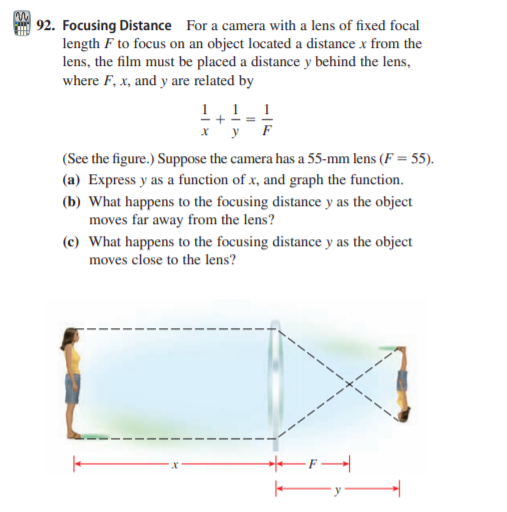| 92. Focusing Distance For a camera with a lens of fixed focal length F to focus on an object located a distance x from the lens, the film must be placed a distance y behind the lens, where F, x, and y are related by 11 1 y (See the figure.) Suppose the camera has a 55-mm lens (F = 55). (a) Express y as a function of x, and graph the function. (b) What happens to the focusing distance y as the object moves far away from the lens? (c) What happens to the focusing distance y as the object moves close to the lens?
| 92. Focusing Distance For a camera with a lens of fixed focal length F to focus on an object located a distance x from the lens, the film must be placed a distance y behind the lens, where F, x, and y are related by 11 1 y (See the figure.) Suppose the camera has a 55-mm lens (F = 55). (a) Express y as a function of x, and graph the function. (b) What happens to the focusing distance y as the object moves far away from the lens? (c) What happens to the focusing distance y as the object moves close to the lens?
Algebra and Trigonometry (6th Edition)
6th Edition
ISBN:9780134463216
Author:Robert F. Blitzer
Publisher:Robert F. Blitzer
ChapterP: Prerequisites: Fundamental Concepts Of Algebra
Section: Chapter Questions
Problem 1MCCP: In Exercises 1-25, simplify the given expression or perform the indicated operation (and simplify,...
Related questions
Question
The Doppler Effect As a train moves toward an observer (see
the figure), the pitch of its whistle sounds higher to the
observer than it would if the train were at rest, because the
crests of the sound waves are compressed closer together. This
phenomenon is called the Doppler effect. The observed pitch
P is a function of the speed √ of the train and is given by

Transcribed Image Text:| 92. Focusing Distance For a camera with a lens of fixed focal
length F to focus on an object located a distance x from the
lens, the film must be placed a distance y behind the lens,
where F, x, and y are related by
11 1
y
(See the figure.) Suppose the camera has a 55-mm lens (F = 55).
(a) Express y as a function of x, and graph the function.
(b) What happens to the focusing distance y as the object
moves far away from the lens?
(c) What happens to the focusing distance y as the object
moves close to the lens?
Expert Solution
This question has been solved!
Explore an expertly crafted, step-by-step solution for a thorough understanding of key concepts.
This is a popular solution!
Trending now
This is a popular solution!
Step by step
Solved in 3 steps with 1 images

Knowledge Booster
Learn more about
Need a deep-dive on the concept behind this application? Look no further. Learn more about this topic, algebra and related others by exploring similar questions and additional content below.Recommended textbooks for you

Algebra and Trigonometry (6th Edition)
Algebra
ISBN:
9780134463216
Author:
Robert F. Blitzer
Publisher:
PEARSON

Contemporary Abstract Algebra
Algebra
ISBN:
9781305657960
Author:
Joseph Gallian
Publisher:
Cengage Learning

Linear Algebra: A Modern Introduction
Algebra
ISBN:
9781285463247
Author:
David Poole
Publisher:
Cengage Learning

Algebra and Trigonometry (6th Edition)
Algebra
ISBN:
9780134463216
Author:
Robert F. Blitzer
Publisher:
PEARSON

Contemporary Abstract Algebra
Algebra
ISBN:
9781305657960
Author:
Joseph Gallian
Publisher:
Cengage Learning

Linear Algebra: A Modern Introduction
Algebra
ISBN:
9781285463247
Author:
David Poole
Publisher:
Cengage Learning

Algebra And Trigonometry (11th Edition)
Algebra
ISBN:
9780135163078
Author:
Michael Sullivan
Publisher:
PEARSON

Introduction to Linear Algebra, Fifth Edition
Algebra
ISBN:
9780980232776
Author:
Gilbert Strang
Publisher:
Wellesley-Cambridge Press

College Algebra (Collegiate Math)
Algebra
ISBN:
9780077836344
Author:
Julie Miller, Donna Gerken
Publisher:
McGraw-Hill Education